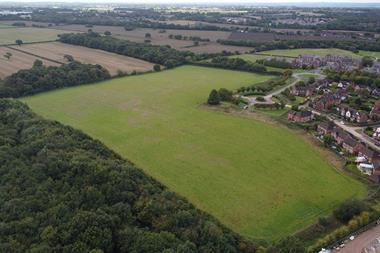Industry is making progress in cutting carbon but recycling existing buildings’ materials remains a big challenge

For many, the climate crisis can feel overwhelming; the scale of the challenge appears so great and the ability as individuals to contribute to change seems so limited. If we are going to come anywhere near to achieving net zero carbon by 2050 and thereby avert the worst implications of climate change, it’s important that we do not allow this to provoke inertia.
Those of us who work in or around the most carbon intensive industries have a particular need to act. Construction is not alone, but it is one such industry. The facts are pretty stark. According to the UK Green Building Council (UKGBC), the wider built environment industry is responsible for 40% of global emissions. And if you examine the whole lifecycle carbon footprint of a typical commercial property, around 50% of its lifetime emissions come from its construction.
Accordingly, if the UK is to meet its obligations under the Paris Agreement – since entrenched in domestic law – the construction industry needs to step up to the plate. So, where has construction got to on the road to net zero? And what steps should we be prioritising as a matter of urgency?
On the whole, the industry has grasped the enormity of the task at hand and is starting to make significant progress. To that end, praise must go to the UKGBC and other industry organisations, which have been banging the drum on this subject for many years now.
Members of the UKGBC, all of which have signed up to some pretty testing commitments, represent some of the country’s most influential construction companies and are responsible for billions of pounds worth of projects every year. They also represent every part of the supply chain, from developers and owners to contractors, subcontractors and consultants. All are taking positive steps to reduce construction’s carbon impact and should be celebrated.
That said, the companies and individuals that are most focused on the road to net zero tend to be those based and operating in major urban areas. They also tend to be the biggest players with the deepest pockets. To truly make progress, SMEs and those outside metropolitan areas need to be brought into the fold.
That will almost certainly require greater regulation. Many other countries have already brought in stricter rules. In France, Finland and the Netherlands, for instance, it is mandatory to assess a project’s whole lifecycle carbon footprint. We don’t require that yet, but are taking the first tentative steps. The London Plan, for instance, demands such assessments, but only for referable – so, the very biggest – projects, which excludes much development.
A private members bill that would have addressed whole lifecycle assessment fell at the first post when the MP concerned was promoted. It has since been resurrected, but many argue this isn’t something that should be coming from the backbenches – it should be a government priority.
Unfortunately, the energy crisis precipitated by the invasion of the Ukraine appears to be diminishing the desire of all governments for radical change. Germany has already started recommissioning coal fired power stations – and that from a coalition government that counts the Greens as a member. The UK government’s decisions to launch a ‘review’ to check whether the UK is meeting its Net Zero 2050 target in “an economically efficient way” and to scrap green levies on energy bills are a signal that in hard times priorities can change.
The response to the crisis has been frustrating on another level. Many have argued for years that a huge programme to retrofit the UK’s energy inefficient homes is necessary, not just for the environment’s sake but also for energy security and to help keep bills down, especially for the worst off. Not enough was done in the good times and we are now in crisis mode.
Yet, we do have to remind ourselves that a lot of people, not least in the construction industry, are trying to effect positive change. It’s just that some of the problems associated with greening construction are particularly knotty. Reusing materials is a good example. In theory, recycling more construction materials should be simple – many of the components are all there for the taking. It is also prevents already embedded carbon from being squandered and more carbon releases generated in the manufacture of new products.
However, a challenge when reusing materials is insufficiently accurate data on performance. As a result, materials need to be tested, and the testing regimes for products such as steel are rigorous and involve both cost and delay. It’s not that recycling isn’t possible – but it can presently be more difficult than just buying new.
Affordable recycled products
The industry is looking at this as it can see that there would be a ready market for affordable recycled products, just as many others are working hard to try to reduce the carbon intensity of steel and concrete production. Cutting edge technologies may ultimately make both building and deconstruction easier. Building information modelling (BIM) and digital twins could become the norm, allowing every part of a structure to be labelled with data on how it performs, and also by whom and when it was manufactured. This should make reuse without extensive testing much easier. To assist further, clients committed to net zero are now insisting that new buildings are designed for deconstruction rather then demolition.
Given that the most sustainable building is the one that is already there and 80% of the buildings that will be in existence in 2050 are already built, to achieve net zero, there needs to be an increasing focus on reuse, adaptation and refurbishment rather than demolition and new build.
At present, the building regulations do not mandate ‘not to exceed’ embedded carbon levels for new buildings and as such there is little regulatory incentive to reuse and adapt, given the possible increased cost of reusing an existing building that might require extensive work to be fit for alternative uses.
The differing VAT treatment of construction costs arising from new build and renovation works is also unhelpful. The Part Z campaign and the House of Commons Environment Audit Committee (amongst others) have called for a move towards ‘not to exceed’ embedded carbon levels for new build, which would give a major boost to retrofitting.
In the meantime, the GLA in the London Plan has included commitments to prioritise retrofitting of existing building over new build. This is already having some impact, with large London new-build projects facing increasing scrutiny of the carbon waste caused by large-scale demolition coupled with the high level of embedded carbon arising from new development.
The reuse of existing buildings may not always be feasible. It is recognised that a ‘deep retrofit’ can take longer and cost more than building new. In addition, it may not be possible to reuse many buildings as they may be unsound or completely unsuitable. It can also be difficult to establish an existing building’s structural integrity and to decide whom should bear the risk of any issues that might come to light during construction.
Despite these risks, major clients with clear net zero commitments are increasingly focussing on the reuse and adaptation of existing buildings where possible, often with great success. The award-winning conversion of the brutalist 1970s Camden Town Hall Extension to the Standard Hotel at Kings Cross is a shining example. Projects that retain the substructure and/or frame of obsolete buildings are becoming more common and in recent cases, in a time of material shortages and inflation, some such projects are even being found to offer cost and time advantages.
Despite the energy crisis and a possible recession, not to mention a questionable political commitment, the construction industry – or at least large parts of it – is pressing ahead on the road to net zero. We are still in the foothills but at least we can see the summit – and have the determination to get there.
Marc Hanson is a partner and co-head of non-contentious construction at Mishcon de Reya






























No comments yet